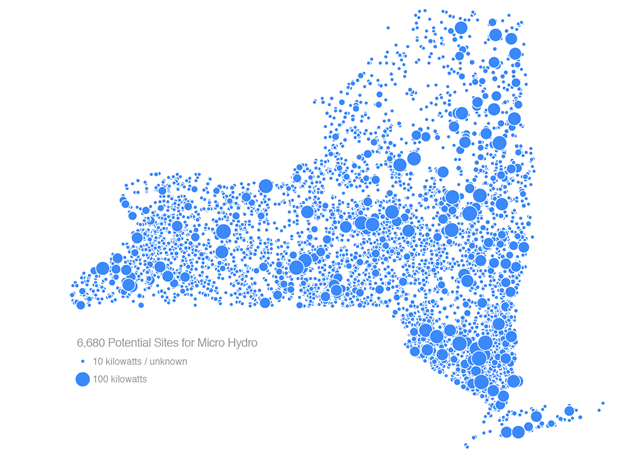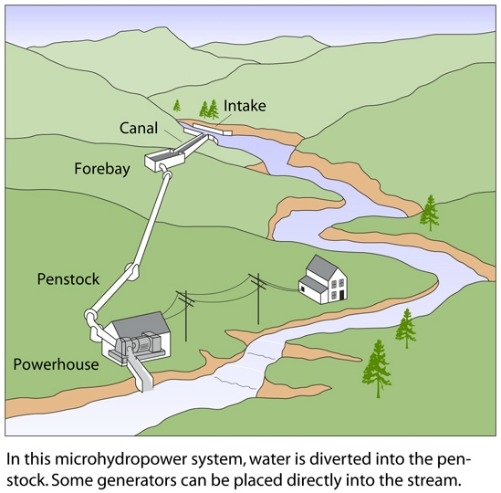
Hydropower has a long history in New York State. There are more than 6,000 dams in New York, some dating back to the 1700s. Even through the industrial revolution of the 19th century, dams were the main source of power for running mills and powering machinery.
As electric power replaced mechanical at the turn of the 20th century, dams were built or repurposed to provide electricity as well. Manors up and down the Hudson Valley, including Bard College’s Montgomery Place, were first electrified using hydropower.
However, with the expansion of grid connections and centralized power production in the second half of the 20th century, these localized sources of power lost their purpose, and thousands sit dormant across the state. As many age and fall into disrepair, we are at a crossroads as to what role, if any, these dams play in our future.
There are three options for dam owners:
- Remove the dam
- Maintain the dam as-is
- Maintain the dam and install microhydropower
Each of these decisions has impacts on the environment, human safety, historic preservation, and the financial burden of the dam owner. Dam removal is the main concern of many environmental organizations, but what of cases where it is not feasible or desirable to take the dam out? Microhydropower is a way to still create environmental benefit, through clean electricity, from dams that are otherwise providing no environmental benefit.
What is “micro”hydropower?

When most people think about hydropower, they think big. Big dams, big reservoirs, and most of all big impacts. Microhydropower is, well, micro. Large hydropower installations, such as the Hoover Dam, disrupt the natural flow of a river to create huge reservoirs. These are then released at times of peak energy demand to create massive amounts of energy. This is called peaking. Conversely, microhydro facilities work using what is called run-of-river management. The natural flow of water dictates the amount of power that it generates.
While microhydropower facilities with no dam do the best job of preserving the natural flow of a river, even in concert with a dam run-of-river management ensures that there are minimal impacts. Because the reservoir and net flow of the river is not being manipulated, the only impact (on top of the impact of the dam) is to the short section of river between the dam and where the diverted water returns from the turbine.
Microhydro also has a small impact because the scale of the facilities is small. Instead of megawatts or gigawatts, microhydropower sites produce between 10 and 100 kilowatts. The small turbines lead to small footprints of the hydropower facilities. Combined across New York State, microhydropower could go a long way to meeting New York’s renewable energy mandate with little to no impact over existing conditions.
Microhydro versus removal–assessing the options
Bard College is fortunate to have two dams on its property that are potential candidates for either microhydropower or for removal. The College is currently undergoing a comprehensive assessment process to decide whether removal or microhydro is the best path forward at these sites. As part of that assessment, the College is creating a decision-making framework to help guide other dam owners who may be wrestling with the same potential choices. The framework consists of the sections below that should be weighed by a dam owner to reach an optimal decision.
Feasibility
First, an owner needs to determine if hydropower is even viable at the site. The amount of possible power at a site is a function of the amount of flow in the river and the vertical drop that can be achieved. The further more water falls, the more energy is able to be generated. Is there enough flow and enough height to generate a meaningful amount of power at the site? If not, microhydropower would not make sense, and the options of maintenance or removal would need to be weighed.
Environmental impact
Every dam has an impact. Dams disrupt the natural flow of rivers, they impede migratory species, and they trap sediment from being distributed downstream. These impacts will vary in degree for every dam, and mitigating them needs to be considered in the cost of maintaining the dam or installing microhydro.
Regulatory process
There is a rigorous process of regulation around hydropower. Permitting needs to be coordinated across the federal, state, and local levels.
Community Engagement
Dam owners need to negotiate with many non-regulatory agencies and organizations as well. Environmental groups, local residents, recreational users all have different wants, needs, and priorities around how a stream or river is managed.
Economic viability
Finally, the costs and benefits of the project need to make sense for the dam owner. Will the project provide enough power to offset the costs of construction, permitting, environmental review, and maintenance?
While Bard will be able to show one possible path for negotiating these considerations, they will vary for each of the thousands of potential sites in New York. It is important to preemptively engage with planners, politicians and residents on a local level to raise awareness of the potential of microhydropower. Is it allowed in your town’s code? Does your town have any dams that could be repowered? New York’s clean energy future could be hiding in your backyard.

I am the owner of an 1800’s grist mill that has long since not been used. I have deeded 75% water rights to the impoundment above the building. There is an existing dam and penstock that runs under the main road that the building fronts on. The mill originally had two turbines in the pit in the basement of the building, one is still in the pit but most likely inoperable. There is approx 10-12′ of head from the impoundment to the pit, with a large amount of flow possible. I am interested in installing turbines, but have no idea of where to start. Would the college have any interest in examining my site and giving some reccomendations?